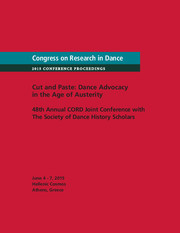No CrossRef data available.
Article contents
Modems and Other Folk: The National Dance Congress and Festival of 1936
Published online by Cambridge University Press: 04 January 2013
Abstract
The May 1936 National Dance Congress and Festival, held at the 92nd Street Y, was organized by more than twenty representatives from various parts of the dance community and attracted fourteen hundred people, with two hundred performing in evening concerts. I explore the political concerns that underpinned the congress and investigate the programming as it reveals a sense of the period's modernism and within an understanding of contemporary immigration and ideas about diversity.
- Type
- Research Article
- Information
- Copyright
- Copyright © The Author(s) 2007


